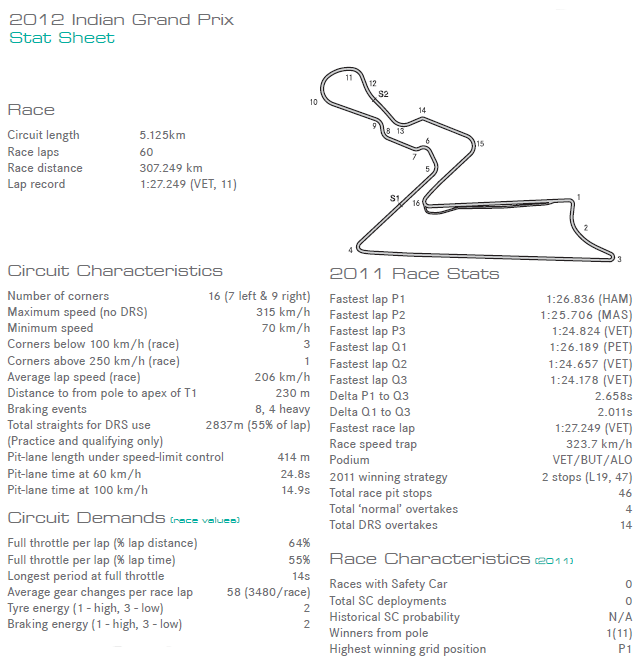Indian GP: Race guide
/dnl.eurosport.com/sd/img/placeholder/eurosport_logo_1x1.png)
ByEurosport
Updated 25/10/2012 at 15:22 GMT
We take an in-depth look at this weekend's Indian Grand Prix.
Lewis Hamilton, Indian Grand Prix 2011
Image credit: Reuters
A Grand Prix on Indian soil was mooted as long ago as 1997 but it took until 2011 for the subcontinent to take its place on the Formula One calendar when the inaugural Indian Grand Prix was held at the brand-new Buddh International Circuit. Built at a cost of $400m, the circuit was widely praised for creating excellent racing as well as providing the cars with a stern challenge thanks to its varied layout and wide range of corner types.
Last year’s race was judged a great success although there was evidence of unfinished construction such as staircases that appeared to lead nowhere and less than reliable sewer pipes, but India embraced the sport with open arms and F1 responded in kind – struck by the scenes of poverty witnessed in the areas around the track, the teams got together and collected all leftover food and drinks from their VIP areas and distributed them to the people living nearby.
TRACK TECH
A popular circuit thanks to its undulating layout, combination of mundane and menacing corners and ultra-quick lap speed, Noida is a demanding circuit for tyres owing to the high ambient temperature and low grip, expected of such a new venue.
A smooth circuit means the teams can run lower ride heights, with less danger of the car bottoming out unless their drivers get particularly well-acquainted with the kerbs. With two long straights, both of which will see DRS in use during the race, teams will look to maximise top-end speed and work on balance and driveability for the slower, technical section in the middle of the lap.
Turn 10 poses an interesting challenge, a quadruple-apex right-hander that is reminiscent of the awesome Turn 8 in Istanbul. It is taken at an average speed of around 130mph and the left front tyre takes a real beating as the G forces load up during the time it takes to traverse the corner.
LAST YEAR
The Indian Grand Prix marked the first opportunity to pay respects to Dan Wheldon and Marco Simoncelli, both of whom lost their lives in racing accidents in the two weeks prior to the race.
Polesitter Sebastian Vettel maintained his lead at the start with Jenson Button vaulting up to second from fourth on the grid. They were to remain first and second throughout, with the action taking place elsewhere on the circuit as, for the fifth time in 2011, Lewis Hamilton and Felipe Massa came together on track, this time Massa turned in on Hamilton on the entry to Turn 5, the McLaren needing to pit for a new front wing. Massa was able to continue but was later handed a drive through penalty for his part in the clash.
Massa’s race came to an abrupt end on lap 32 when he suffered a suspension failure, brought about by clouting the kerbs at Turn 7 a touch too enthusiastically, mirroring an identical failure suffered by him in qualifying the previous day. Fernando Alonso completed the podium with Vettel leading Button home by just over eight seconds.
TRACK CHARACTERISTICS
Tyre wear: 7/10

A lack of track knowledge forced Pirelli to be conservative in 2011 but this year the hard and soft tyres are expected to have a lap time difference of up to two seconds, greatly increasing the tactical challenge for team strategists. The longest pitlane on the calendar means everyone will try to get by on two stops, though that may be easier said than done.
Downforce: 4/10
With several long straights, including two independent DRS zones, the Noida circuit is quick and flowing. Direction changes through the sequence from Turns 5-14 are mesmerising and really show off a well-sorted car.
Average speed: 8/10
Hitting 200mph on the 1.2km back straight, and with only a few corners where second gear is needed means the Buddh International Circuit scores highly here.
Track difficulty: 7/10
There are two distinct sections to this circuit – the first section down to and including Turn 4 is not challenging, with three second gear corners, two long straights and a flat-out left-hander. From Turn 5 through to Turn 14, every apex must be millimetre-perfect as each corner flows into the next – get one wrong and it’ll punish you for the rest of the lap.
Overtaking: 6/10
DRS zones across the start/finish straight and into Turn 4 at the end of the 200mph back straight provide the best chances, though judicious use of KERS can open up opportunities into Turn 5 and also Turn 16 at the end of the lap.
Spectacle: 8/10
F1’s visit to India was an eye-watering assault on the senses last year, but the burgeoning Indian middle class meant the race was well-attended, even if tickets cost the equivalent of a month’s wage for the country’s poorer citizens. Expect Force India and local hero Narain Karthikeyan to be in the spotlight all weekend – a good weekend by either driver will be met with raucous enthusiasm in the grandstands.
KEY STATS
Venue Buddh International Circuit, Greater Noida
Length 5.137km
Laps 60
Lap record 1m 27.249s – Sebastian Vettel, Red Bull (2011)
2011 Winner Sebastian Vettel, Red Bull
GP History (only races held as part of the Formula One World Championship are included):
Buddh 2011-present

Stats from Mercedes AMG Petronas
Scan me
Related Topics
Share this article
Advertisement
Advertisement